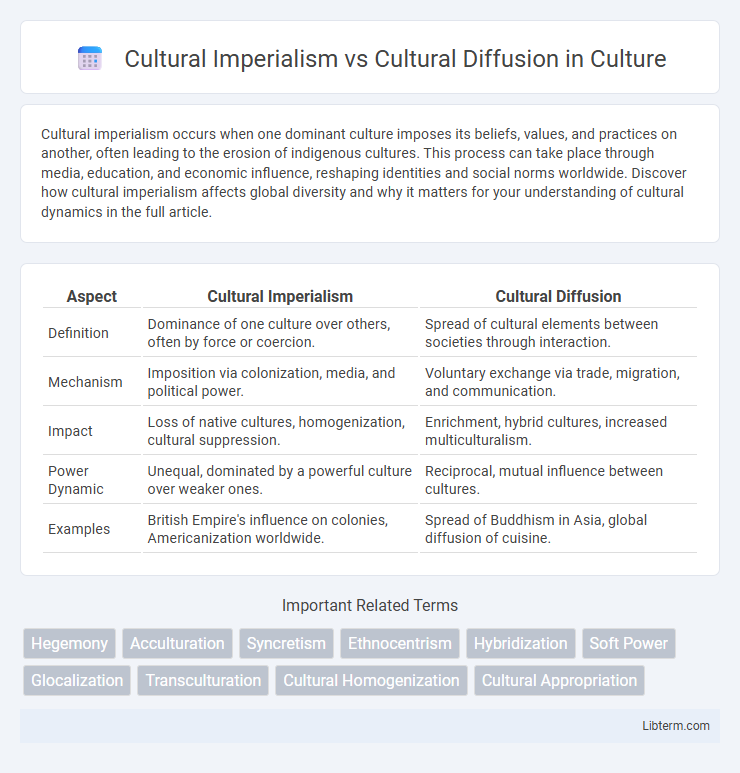Cultural imperialism occurs when one dominant culture imposes its beliefs, values, and practices on another, often leading to the erosion of indigenous cultures. This process can take place through media, education, and economic influence, reshaping identities and social norms worldwide. Discover how cultural imperialism affects global diversity and why it matters for your understanding of cultural dynamics in the full article.
Table of Comparison
| Aspect | Cultural Imperialism | Cultural Diffusion |
|---|---|---|
| Definition | Dominance of one culture over others, often by force or coercion. | Spread of cultural elements between societies through interaction. |
| Mechanism | Imposition via colonization, media, and political power. | Voluntary exchange via trade, migration, and communication. |
| Impact | Loss of native cultures, homogenization, cultural suppression. | Enrichment, hybrid cultures, increased multiculturalism. |
| Power Dynamic | Unequal, dominated by a powerful culture over weaker ones. | Reciprocal, mutual influence between cultures. |
| Examples | British Empire's influence on colonies, Americanization worldwide. | Spread of Buddhism in Asia, global diffusion of cuisine. |
Introduction to Cultural Imperialism and Cultural Diffusion
Cultural imperialism refers to the dominance of one culture over others, often driven by economic, political, or military power, leading to the imposition of the dominant culture's values, customs, and practices. Cultural diffusion involves the natural spread of cultural elements such as language, religion, technology, and traditions between societies through trade, migration, or communication. While cultural imperialism enforces uniformity, cultural diffusion fosters diversity by blending and exchanging cultural traits across different communities.
Defining Cultural Imperialism: Meaning and Examples
Cultural imperialism refers to the dominance of one culture over others, often through media, language, or economic influence, leading to the erosion or replacement of local cultures. A prominent example is the global spread of Western brands, movies, and values reshaping traditional societies across Asia and Africa. This phenomenon highlights power imbalances where dominant cultures impose their norms, sometimes causing resistance or hybridization in the affected regions.
Understanding Cultural Diffusion: Key Concepts
Cultural diffusion involves the spread of beliefs, customs, and technologies from one group to another, enriching societies through the exchange of ideas. Unlike cultural imperialism, which imposes dominant cultural values often suppressing local traditions, diffusion promotes mutual influence and adaptation. Key concepts of cultural diffusion include expansion diffusion, relocation diffusion, and hierarchical diffusion, which describe how cultural elements spread geographically and socially.
Historical Contexts of Cultural Imperialism
Cultural imperialism historically emerged through European colonial expansion from the 15th to the 20th centuries, where dominant powers imposed their language, religion, and customs on colonized societies, leading to significant cultural homogenization. This process often erased indigenous traditions, reshaping political and social structures to favor imperial interests, evident in British rule in India and French control in North Africa. Cultural diffusion, by contrast, involves more organic, reciprocal exchanges of cultural elements without coercion, allowing for mutual adaptation and hybridization.
Mechanisms of Cultural Diffusion Across Societies
Cultural diffusion occurs through mechanisms such as trade, migration, and communication technologies that facilitate the exchange of ideas, beliefs, and practices across societies. Unlike cultural imperialism, which involves the dominance of one culture over others often through coercion or economic control, cultural diffusion emphasizes mutual influence and adaptation. Key channels include mass media, educational exchanges, and global tourism, all contributing to the dynamic spread and blending of cultural traits worldwide.
Comparing Impacts: Cultural Imperialism vs Cultural Diffusion
Cultural imperialism imposes dominant cultural values and practices on subordinate societies, often leading to the erosion of indigenous traditions and loss of cultural diversity. Cultural diffusion, by contrast, facilitates the exchange and blending of cultural elements through voluntary interaction, promoting multiculturalism and innovation. The impact of cultural imperialism is frequently associated with power imbalances and cultural homogenization, whereas cultural diffusion encourages mutual influence and preservation of unique cultural identities.
Media’s Role in Spreading Culture
Media plays a pivotal role in cultural diffusion by transmitting ideas, values, and traditions across global audiences, facilitating intercultural exchange and mutual understanding. However, cultural imperialism manifests when dominant media conglomerates disproportionately project one culture's narratives, often overshadowing local cultures and imposing foreign values. The globalization of digital platforms intensifies this dynamic, shaping cultural identities and consumption patterns worldwide.
Case Studies: Globalization and Cultural Change
The case studies of globalization illustrate the dynamics between cultural imperialism and cultural diffusion, where dominant cultures often impose values and practices through media and economic power, as seen with Western influence in non-Western countries. Cultural diffusion occurs when local cultures selectively adapt foreign elements, creating hybrid identities, exemplified by the fusion of traditional Asian cuisine with Western fast food in urban centers. These patterns underscore complex cultural exchanges that reshape social norms and identities worldwide amid globalization-driven cultural change.
Resistance and Adaptation to Cultural Influences
Resistance to cultural imperialism often involves the preservation of indigenous languages, traditions, and social norms against dominant external forces seeking to impose their values. Cultural diffusion encourages adaptation by blending foreign elements with local customs, resulting in hybrid cultural expressions that reflect mutual influence rather than domination. Communities facing cultural imperialism may reject imposed practices, while adapting selectively during cultural diffusion enables the evolution and enrichment of cultural identities.
Conclusion: Navigating Cultural Exchange in a Globalized World
Navigating cultural exchange in a globalized world requires balancing the preservation of local identities with the benefits of cultural diffusion, which fosters innovation and mutual understanding. Cultural imperialism risks homogenizing diverse cultures, often imposing dominant values and eroding indigenous traditions. Emphasizing respectful intercultural dialogue and equitable cultural interactions can mitigate these risks and promote a more inclusive global society.
Cultural Imperialism Infographic

 libterm.com
libterm.com